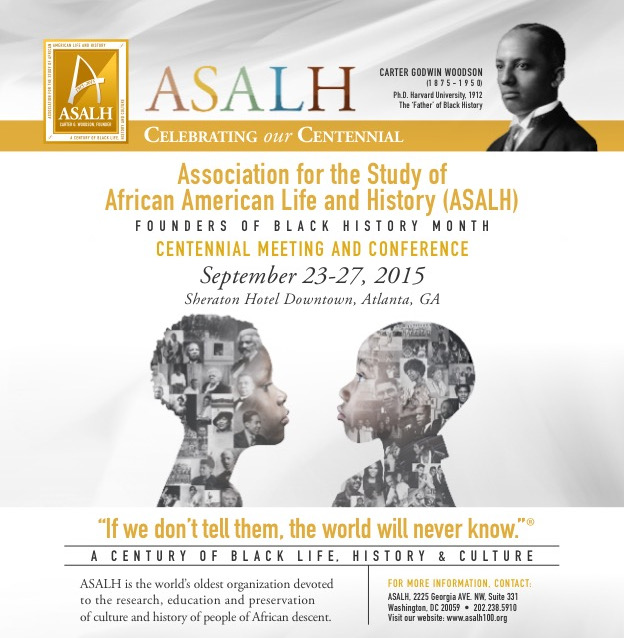A Century of Black Life, History, and Culture
100th Annual ASALH Meeting and Conference
September 23-27, 2015: Atlanta, Georgia
Over the past century, African American life, history, and culture have become mayor forces in the United States and the world. In 1915, few could have imagined that African Americans in music, art, and literature would become appreciated by the global community. Fewer still could have predicted the prominence achieved by African Americans, as well as other people of African descent, in shaping world politics, war, and diplomacy. Indeed, it was nearly universally believed that Africans and people of African descent had played no role in the unfolding of history and were a threat to American Civilization itself. A century later, few can deny the centrality of African Americans in the making of American history.
This transformation is the result of effort, not chance. Confident that their struggles mattered in human history, black scholars, artists, athletes, and leaders self-consciously used their talents to change how the world viewed African Americans. The New Negro of the post-World War I era made modernity their own and gave the world a cornucopia of cultural gifts, including jazz, poetry based on the black vernacular, and an appreciation of African art. African American athletes dominated indiVidual and team sports transforming baseball, track-and-field, football, boxing, and basketball. In a wave of social movements, African American activism transformed race relations, challenged American foreign policy, and became the American conscience on human rights.
While the spotlight often shines on individuals, this movement is the product of organization, of institutions and institution~bullders who gave direction to effort. The National Urban League promoted the Harlem Renaissance. The preservation of the black past became the mission of Arturo Schomburg and Jesse Moorland, leading to the rise of the Schomburg Research Center in Black Culture and Howard University's Moorland-Spingarn Research Center: The vision of Margaret Boroughs and others led to the African American museum movement, leading to the creation of black museums throughout the nation, culminating with the Smithsonian's National Museum of African American History and Culture. Student actiVIsm of the 19605 resulted in the Black Studies Movement and the creation of black professional associations, including the National Council of Black Studies, and a host of doctoral programs at mayor American universities.
At the dawn of these strivings and at all points along the road, the Association for the Study of Negro Life and History, now the Association for the Study of African American Life and History (ASALH) has played a Vital role. When he founded the Association in 1915, Carter 6. Woodson labored under the belief that historical truth would crush falsehoods and usher in a new era of equality, opportunity, and racial democracy, and it has been its charge for a century. In honor of this milestone, ASALH has selected "A Century of Black Life, History, and Culture" as the 2015 National Black History theme.











